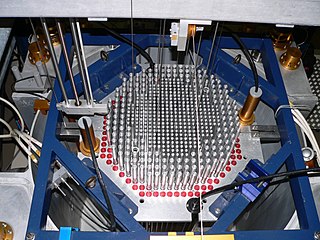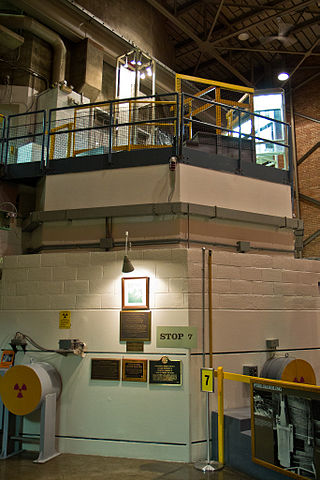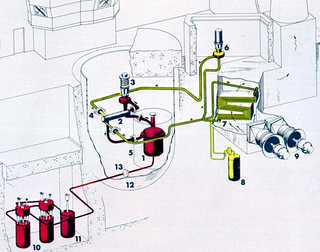S3G may refer to:
- S3G reactor : A naval reactor used by the US Navy.
- S3G, a diode electrical component
S3G may refer to:

A nuclear reactor is a device used to initiate and control a fission nuclear chain reaction or nuclear fusion reactions. Nuclear reactors are used at nuclear power plants for electricity generation and in nuclear marine propulsion. Heat from nuclear fission is passed to a working fluid, which in turn runs through steam turbines. These either drive a ship's propellers or turn electrical generators' shafts. Nuclear generated steam in principle can be used for industrial process heat or for district heating. Some reactors are used to produce isotopes for medical and industrial use, or for production of weapons-grade plutonium. As of 2022, the International Atomic Energy Agency reports there are 422 nuclear power reactors and 223 nuclear research reactors in operation around the world.
OCR may refer to:
Reactor may refer to:
Brest most commonly refers to:

A breeder reactor is a nuclear reactor that generates more fissile material than it consumes. These reactors can be fueled with more-commonly available isotopes of uranium and thorium, such as uranium-238 and thorium-232, as opposed to the rare uranium-235 which is used in conventional reactors. These materials are called fertile materials since they can be bred into fuel by these breeder reactors.
BN, Bn or bn may refer to:

USS Will Rogers (SSBN-659) was a Benjamin Franklin-class ballistic missile submarine – the last of the "41 for Freedom" Polaris submarines. She was the only ship of the United States Navy to be named for humorist Will Rogers (1879–1935).
The S3G reactor is a naval reactor used by the United States Navy to provide electricity generation and propulsion on warships. The S3G designation stands for:

Experimental Breeder Reactor I (EBR-I) is a decommissioned research reactor and U.S. National Historic Landmark located in the desert about 18 miles (29 km) southeast of Arco, Idaho. It was the world's first breeder reactor. At 1:50 p.m. on December 20, 1951, it became one of the world's first electricity-generating nuclear power plants when it produced sufficient electricity to illuminate four 200-watt light bulbs. EBR-I subsequently generated sufficient electricity to power its building, and continued to be used for experimental purposes until it was decommissioned in 1964. The museum is open for visitors from late May until early September.

A molten-salt reactor (MSR) is a class of nuclear fission reactor in which the primary nuclear reactor coolant and/or the fuel is a mixture of molten salt with a fissionable material.

The Chernobyl disaster began on 26 April 1986 with the explosion of the No. 4 reactor of the Chernobyl Nuclear Power Plant near the city of Pripyat in the north of the Ukrainian SSR, close to the border with the Byelorussian SSR, in the Soviet Union. It is one of only two nuclear energy accidents rated at seven—the maximum severity—on the International Nuclear Event Scale, the other being the 2011 Fukushima nuclear accident. The initial emergency response and subsequent mitigation efforts involved more than 500,000 personnel and cost an estimated 18 billion roubles—roughly US$68 billion in 2019, adjusted for inflation. It was the worst nuclear disaster in history, and the costliest disaster in human history, costing an estimated US$700 billion.
The S5W reactor is a nuclear reactor used by the United States Navy to provide electricity generation and propulsion on warships. The S5W designation stands for:
A liquid metal cooled nuclear reactor, or LMR is a type of nuclear reactor where the primary coolant is a liquid metal. Liquid metal cooled reactors were first adapted for breeder reactor power generation. They have also been used to power nuclear submarines.

The Molten-Salt Reactor Experiment (MSRE) was an experimental molten-salt reactor research reactor at the Oak Ridge National Laboratory (ORNL) in Oak Ridge, Tennessee. This technology was researched through the 1960s, the reactor was constructed by 1964, it went critical in 1965, and was operated until 1969. The costs of a cleanup project were estimated at $130 million.
Arc reactor may refer to:
Zoe or variants may refer to:
A nuclear reactor coolant is a coolant in a nuclear reactor used to remove heat from the nuclear reactor core and transfer it to electrical generators and the environment. Frequently, a chain of two coolant loops are used because the primary coolant loop takes on short-term radioactivity from the reactor.
The Bharatiya Nabhikiya Vidyut Nigam Limited (BHAVINI) is a wholly owned Enterprise of Government of India under the administrative control of the Department of Atomic Energy incorporated on 22 October 2003 as a Public Limited Company under the Companies Act, 1956 with the objective of constructing and commissioning the first 500 MWe Fast Breeder Reactor (FBR) at Kalpakkam in Tamil Nadu and to pursue construction, commissioning, operation and maintenance of subsequent Fast Breeder Reactors for generation of electricity in pursuance of the schemes and programmes of Government of India under the provisions of the Atomic Energy Act, 1962. BHAVINI is currently constructing a 500MWe Prototype Fast Breeder Reactor at Kalpakkam, 70 km from Chennai.